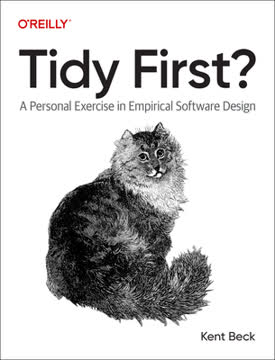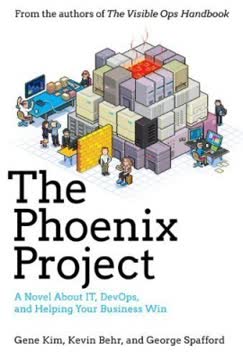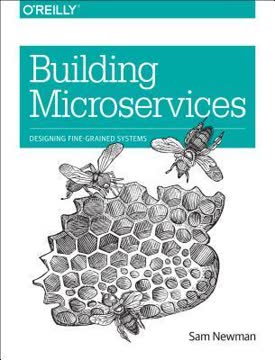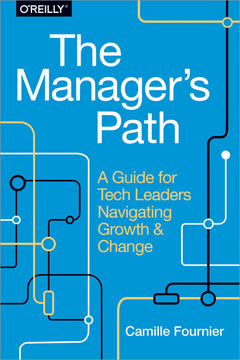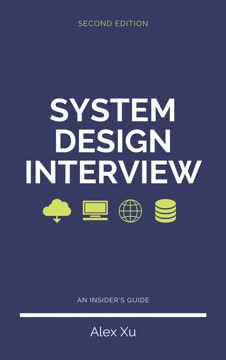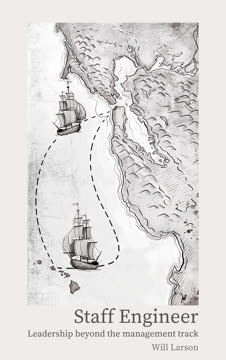نکات کلیدی
1. ابتدا خود را مدیریت کنید، سپس دیگران را
سعی کنید تا حد امکان اطلاعات کمتری در ذهن خود نگه دارید.
جریان کار خود را سازماندهی کنید. به عنوان یک مدیر، اطلاعات ارزشمندترین دارایی شماست. سیستمی برای ضبط، سازماندهی و اولویتبندی وظایف و اطلاعات پیادهسازی کنید. از تقویم برای سازماندهی زمان، لیست کارها برای وظایف، صندوق ورودی ایمیل برای پیامهای ورودی و ابزاری جداگانه برای ضبط اطلاعات در حال حرکت استفاده کنید. این سیستم به شما کمک میکند تا بر مسئولیتهای خود مسلط شوید و فضای ذهنی برای تفکر استراتژیک آزاد کنید.
انرژی خود را مدیریت کنید. درک کنید که انرژی و حالت روحی شما بر تیمتان تأثیر میگذارد. در طول روز به وضعیت خود توجه کنید و اقداماتی برای مدیریت آن انجام دهید. اگر احساس ناامیدی یا استرس میکنید، قبل از تعامل با تیمتان لحظهای برای بازنشانی بگذارید. به یاد داشته باشید که نقش شما به عنوان یک مدیر، ایجاد ثبات است، بنابراین مهارتهای خودآگاهی و تنظیم عاطفی را پرورش دهید.
2. ارتباطات و تفویض وظایف مهارتهای مدیریتی ضروری هستند
حباب فکری را بالای سرشان نگه دارید.
ارتباطات را تسلط کنید. ارتباط مؤثر پایه و اساس مدیریت موفق است. یاد بگیرید که سبک ارتباطی خود را با رسانهها و افراد مختلف تطبیق دهید. گوش دادن فعال را تمرین کنید، سوالات باز بپرسید و اطلاعات واضح و مختصر ارائه دهید. از مفهوم "صراحت رادیکال" برای ارائه بازخوردی که هم مهربان و هم مستقیم است استفاده کنید.
تفویض وظایف به صورت استراتژیک. تفویض وظایف فقط به معنای تخصیص کارها نیست؛ بلکه به معنای توانمندسازی تیمتان و به حداکثر رساندن پتانسیل آنهاست. از مقیاس تفویض وظایف برای تعیین سطح مناسب حمایت برای هر وظیفه و عضو تیم استفاده کنید. به یاد داشته باشید که شما مسئولیت را تفویض میکنید، نه حسابرسی. تفویض وظایف مؤثر به شما اجازه میدهد تا از مهارتهای تیمتان بهرهبرداری کنید در حالی که بر وظایف مدیریتی با تأثیر بالا تمرکز میکنید.
3. جلسات یکبهیک سنگبنای مدیریت مؤثر هستند
جلسات یکبهیک یکی از مهمترین فعالیتهای منظم است که به عنوان یک مدیر انجام خواهید داد.
ساختار جلسات یکبهیک خود را تنظیم کنید. برای جلسات یکبهیک با هر عضو تیم یک نظم منظم برقرار کنید. از یک سند مشترک برای حفظ یک دستور کار مداوم و پیگیری موارد عملی استفاده کنید. روابط جدید را با یک تمرین "قرارداد" برای تعیین انتظارات و درک سبکهای کاری یکدیگر آغاز کنید.
جلسه را به آنها اختصاص دهید. اعضای تیمتان را تشویق کنید تا دستور جلسه را هدایت کنند و بیشتر صحبت کنند. از سوالات باز برای هدایت گفتگو و کشف مسائل یا فرصتها استفاده کنید. موضوعات میتوانند شامل موارد زیر باشند:
- پیشرفت در پروژههای جاری
- اهداف توسعه حرفهای
- چالشها یا موانع
- بازخورد (دو طرفه)
- رفاه شخصی
به یاد داشته باشید که جلسات یکبهیک جلسات بهروزرسانی وضعیت نیستند، بلکه فرصتهایی برای ارتباط عمیقتر و توسعه هستند.
4. انگیزههای فردی را برای به حداکثر رساندن عملکرد تیم درک کنید
مسئله یافتن فرد مناسب برای کار نیست، بلکه یافتن کار مناسب برای فرد است.
از سلسله مراتب نیازهای مازلو استفاده کنید. درک کنید که اعضای تیمتان نیازهایی فراتر از یک حقوق دارند. سعی کنید محیطی ایجاد کنید که از نیازهای سطح بالاتر آنها حمایت کند:
- تعلق: انسجام و شمول تیمی را تقویت کنید
- احترام: شناخت و فرصتهای رشد را فراهم کنید
- خودشکوفایی: کار را با اهداف و ارزشهای شخصی هماهنگ کنید
از نقاط قوت فردی بهرهبرداری کنید. درک کنید که اعضای تیم انگیزهها و سبکهای کاری متفاوتی دارند. برخی در ثبات و تسلط (سازندگان کلیسا) پیشرفت میکنند، در حالی که دیگران به تنوع و چالشهای جدید (بازدیدکنندگان بازار) نیاز دارند. وظایف و فرصتهای توسعه را متناسب با این ترجیحات فردی تنظیم کنید و اعضای تیم را در "منطقه توسعه نزدیک" خود نگه دارید تا رشد و مشارکت را ترویج کنید.
5. پیچیدگیهای استخدام و خروج کارکنان را مدیریت کنید
افراد همیشه خواهند رفت. این طبیعی است و ناخوشایند.
استخدام به صورت استراتژیک. به استخدام به عنوان فرصتی برای افزایش قابلیتهای تیمتان نگاه کنید. نه تنها مهارتهای فنی، بلکه تناسب تیمی و تنوع فکری را نیز در نظر بگیرید. توصیفهای شغلی فراگیر بنویسید، مصاحبههای عادلانه انجام دهید و تصمیمات را بر اساس شواهد بگیرید نه احساسات.
خروجها را با ظرافت مدیریت کنید. درک کنید که گردش کارکنان بخشی طبیعی از کسبوکار است. وقتی کسی میرود:
- دلایل آنها را بفهمید (اگر داوطلبانه باشد)
- انتقال روان را تسهیل کنید
- مصاحبه خروجی برای جمعآوری بینشها انجام دهید
- از این فرصت برای بازنگری در ساختار و نیازهای تیم استفاده کنید
برای خروجهای غیر داوطلبانه، از برنامههای بهبود عملکرد (PIPs) به عنوان ابزاری برای بهبود واقعی استفاده کنید، نه فقط به عنوان پیشدرآمدی برای خاتمه. همیشه با همدلی و حرفهایگری به این موقعیتها نزدیک شوید.
6. چالشهای محل کار را با انعطافپذیری و استراتژی مدیریت کنید
نمیتوانید امواج را متوقف کنید، اما میتوانید یاد بگیرید که چگونه موجسواری کنید.
موقعیتهای پر فشار را هدایت کنید. هنگامی که تحت نظارت شدید (چشم سائورون) هستید، تمرکز کنید بر:
- همراستا کردن تیم با اهداف واضح
- بیش از حد ارتباط برقرار کردن پیشرفت و چالشها
- عملگرایی در مورد مبادلات
- رهبری از جلو
جریان اطلاعات را مدیریت کنید. به عنوان یک مدیر، اغلب به اطلاعات حساس دسترسی دارید. یاد بگیرید که اطلاعات را دستهبندی کنید (کاملاً محرمانه، جعبه بسته، جعبه باز) و به طور مناسب به اشتراک بگذارید. در رویکرد خود ثابتقدم باشید تا از ایجاد بیاعتمادی یا سردرگمی جلوگیری کنید.
تمرین رها کردن. درک کنید که نمیتوانید همه چیز را کنترل کنید. بر آنچه میتوانید تأثیر بگذارید تمرکز کنید و اهداف داخلی را به جای اهداف خارجی تعیین کنید. با مدیریت مؤثر زمان و انرژی خود، فضایی برای خلاقیت و تفکر استراتژیک ایجاد کنید.
7. فرهنگ یادگیری و بهبود مستمر را پرورش دهید
ارتباطات طراحی نرمافزار را تعیین میکند.
سیلوها را بشکنید. همکاری بین تیمی را از طریق:
- انجمنها: گروههای مبتنی بر علاقه که تیمها را در بر میگیرند
- سخنرانیهای دپارتمانی: جلسات منظم برای به اشتراکگذاری دانش
- تحلیل "پنج چرا": بررسی عمیق علل ریشهای مسائل
حلقههای بازخورد را پیادهسازی کنید. از ابزارهایی مانند بررسیهای سلامت برای ارزیابی منظم عملکرد و روحیه تیم استفاده کنید. سیستمهایی برای ضبط و عمل بر روی پیشنهادات ایجاد کنید، مانند سیستم بلیطهای "اشکالات مدیریتی".
تصمیمات و یادگیریها را مستند کنید. از روشهایی مانند سوابق تصمیمگیری معماری (ADRs) برای ضبط زمینه و استدلال پشت انتخابهای مهم استفاده کنید. این کار یک پایگاه دانش ارزشمند برای اعضای تیم فعلی و آینده ایجاد میکند.
با تمرکز بر این حوزههای کلیدی، میتوانید به یک مدیر مهندسی مؤثر تبدیل شوید که نه تنها نتایج را ارائه میدهد، بلکه محیطی ایجاد میکند که در آن اعضای تیم میتوانند رشد و پیشرفت کنند.
آخرین بهروزرسانی::
FAQ
What's Become an Effective Software Engineering Manager about?
- Focus on Management Skills: The book is a comprehensive guide for software engineers transitioning into management roles, emphasizing effective leadership and communication.
- Practical Techniques: It offers hands-on tools and techniques for managing teams, improving productivity, and fostering a positive work culture.
- Real-World Scenarios: James Stanier uses real-world examples and anecdotes to illustrate key concepts, making the advice relatable and actionable.
Why should I read Become an Effective Software Engineering Manager?
- Addressing a Skills Crisis: The book tackles the management-skills crisis in the tech industry, equipping readers with the tools to become effective leaders.
- Empowerment for New Managers: It provides actionable insights and frameworks to help new managers navigate their roles confidently and effectively.
- Improving Team Dynamics: Readers can learn how to enhance team dynamics, leading to better collaboration and productivity.
What are the key takeaways of Become an Effective Software Engineering Manager?
- Effective Communication: Clear and open communication is essential for successful management, helping to align team goals and expectations.
- Delegation is Crucial: Effective delegation allows teams to grow and develop their skills while freeing up the manager's time for strategic tasks.
- Embrace Coaching and Mentorship: The book highlights the importance of coaching and mentorship in fostering a supportive environment for team members.
What are the best quotes from Become an Effective Software Engineering Manager and what do they mean?
- “You can’t stop the waves, but you can learn to surf.”: This quote emphasizes adapting to challenges rather than trying to control every situation.
- “Your output is defined as the output of your team combined with the output of the others that you influence.”: It highlights the manager's role in facilitating team success and influencing broader organizational outcomes.
- “A tidy home, tidy mind.”: This suggests that maintaining organization and clarity in your work environment can lead to improved focus and productivity.
How does Become an Effective Software Engineering Manager address the issue of work-life balance?
- Promotes Healthy Boundaries: The book encourages managers to set boundaries to prevent work from encroaching on personal time, which is vital for mental health.
- Encourages Self-Care: It emphasizes the importance of self-care practices, such as exercise and mindfulness, to maintain well-being and effectiveness as a manager.
- Challenges Hustle Culture: The author critiques the hustle culture prevalent in tech, advocating for a more balanced approach to work that values quality over quantity.
What is the Zone of Proximal Development in Become an Effective Software Engineering Manager?
- Learning Framework: This concept describes the difference between what a learner can do without help and what they can achieve with guidance.
- Application in Management: Managers should assign tasks that challenge employees just beyond their current capabilities while providing support to help them succeed.
- Skill Development: This approach fosters skill development and encourages mentorship, allowing team members to grow and take on more complex tasks over time.
How does Maslow’s Hierarchy of Needs relate to management in Become an Effective Software Engineering Manager?
- Understanding Motivation: The book uses Maslow’s model to explain what motivates individuals at work, emphasizing that fulfilling higher-level needs leads to greater job satisfaction and performance.
- Focus on Self-Actualization: Managers should aim to help their team members achieve self-actualization by providing opportunities for growth, challenge, and recognition.
- Creating a Supportive Environment: By addressing both basic and psychological needs, managers can create a supportive environment that fosters employee engagement and retention.
What is the contracting exercise for one-on-ones in Become an Effective Software Engineering Manager?
- Setting Expectations: The contracting exercise involves discussing mutual expectations between the manager and the employee during their first one-on-one meeting.
- Structured Conversation: It provides a structured way to talk about support needs, feedback preferences, and potential challenges in the working relationship.
- Building Trust: This exercise helps establish a foundation of trust and open communication, setting the tone for future interactions.
How can I effectively delegate tasks as a manager according to Become an Effective Software Engineering Manager?
- Maintain Accountability: When delegating, ensure that you retain accountability for the task while giving responsibility to the team member, allowing them to learn and grow.
- Assess Skill Levels: Use the scale of delegation to determine how much guidance and support each task requires based on the individual’s experience and capabilities.
- Encourage Growth: Delegate tasks that are within the employee’s zone of proximal development, providing the right level of challenge and support to facilitate their development.
What techniques does James Stanier suggest for effective communication in Become an Effective Software Engineering Manager?
- Over-Communicate During Stress: In high-pressure situations, increasing communication frequency helps keep stakeholders informed and aligned.
- Use Clear Channels: Establishing clear communication channels, such as dedicated chat rooms or regular updates, ensures that everyone is on the same page.
- Encourage Feedback: Creating an environment where feedback is welcomed fosters open dialogue and helps address concerns before they escalate.
How can I implement a mentorship program based on Become an Effective Software Engineering Manager?
- Create a Mentorship Matrix: Develop a matrix that lists potential mentors and mentees within your organization, detailing their skills and areas for growth.
- Establish Clear Agreements: Encourage mentors and mentees to create agreements outlining their goals, expectations, and boundaries for the relationship.
- Promote Participation: Share the mentorship program with your team and encourage participation by highlighting the benefits of mentorship for both parties.
What is the significance of the "Five Whys" technique in Become an Effective Software Engineering Manager?
- Root Cause Analysis: The "Five Whys" technique helps teams identify the root cause of problems by repeatedly asking "why" until the underlying issue is uncovered.
- Encourages Team Learning: This method fosters a culture of learning from mistakes, allowing teams to improve processes and prevent future issues.
- Documentation of Findings: Documenting the findings from a "Five Whys" session creates a reference for future problem-solving and helps maintain accountability.
نقد و بررسی
کتاب مدیر مؤثر مهندسی نرمافزار شوید به دلیل ارائهی توصیههای جامع و عملی برای مدیران مهندسی تازهکار و با تجربه، تحسینهای زیادی دریافت کرده است. خوانندگان از پوشش موضوعاتی مانند جلسات یکبهیک، استخدام، پویایی تیم و کار از راه دور قدردانی میکنند. دیدگاه معاصر کتاب و سبک نوشتاری قابلفهم آن بهطور مکرر مورد اشاره قرار میگیرد. بسیاری از افراد این کتاب را برای درک انتقال از توسعهدهنده به مدیر ارزشمند میدانند. در حالی که برخی از مدیران با تجربه بخشهایی از آن را بدیهی میدانند، اکثر افراد توافق دارند که این کتاب منبعی ضروری برای کسانی است که تازه وارد نقشهای مدیریت مهندسی شدهاند یا به آن فکر میکنند.
Similar Books
